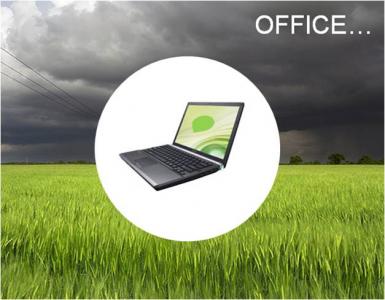- 41 reads
Spend $120 now and SAVE $60 each year... ROI = 50%
Computers are the largest energy consumers among office equipment. Each workstation, with a computer and monitor, left on after business hours is responsible for nearly one ton of CO2 emissions per year. To put this in perspective, the average annual worldwide CO2 emissions is 4 tons per person per year, while the US emission per person is over 14 tons per year. If a workstation is switched off at night and set to go to “sleep” during idle periods in the day, it would cut the waste by 80 percent. If every US computer and monitor were turned off at night, we could shut down eight large power stations and avoid emitting 7 million tons of CO2 every year. Save the planet, but also save your money.
The average US employee uses $568 of energy each year and office Equipment & Computers typically account for 20% or $113 per employee. ENERGY STAR® computers and monitors (15") save about 50 percent on electricity costs, automatically power down when not in use, and they are available from almost every manufacturer. Both computers and monitors power down to about 15% of their maximum power usage. An average office computer and monitor will use $93 per year of electricity if it is left on at night versus only $21 if it is shut off. You still want to consider standby power reduction to shut down the power drawn from peripherals when they are not in use.
There are two myths that are NOT true: "Screen savers save energy," and "It's better for the computer to leave it on." These are flat out false. If you use screen savers make sure they are compatible with your computer’s power management features, as many will actually prevent your computer from going into the power-saver mode. It may also be necessary to make sure that the power saving features are enabled on your computers and that you have the power-down time set to an acceptable level for your operation. Monitors use most of the energy at a workstation and if it’s shut down when nobody’s at the computer, the savings add up.
New flat panel liquid crystal display (LCD) monitors use quite a bit less energy than the conventional cathode ray monitors. The LCD monitors are expensive, but if you are considering new monitors, the energy savings may justify the extra expense. Laptops use between 10 and 50% of the electricity consumed by typical desktop computers. The cost of laptops has continued to drop as the competition and technology increases, so there are many brands that are close in cost to a desktop equivalent. With file storage on servers, you can also think of the laptop as more of a tool and conduit to information than a storage system.
When buying a laptop, look for systems comprised completely of 3.3-volt components (processor, memory and LCD). These systems use about half of the energy of 5.0-volt systems, and are generally equipped with a lighter battery. Computers overall were actually the first devices to earn an ENERGY STAR® rating back in 1992, according to the Environmental Protection Agency (EPA). Since then, the efficiency standards have changed as well as the energy 'landscape', so on July 1, 2009, ENERGY STAR® implements a Tier-2 specification for PCs that will outline additional standards for computers outside the top tier.
The ROI Calculation is based on saving $60 per year per with an ENERGY STAR® computer and monitor for each work station. As systems get outdated look for the new Tier-2 specifications and energy efficient options and also consider laptops which use less power than desktop computers. As a benchmark, 'traditional' computers typically use 55 watts of power and Monitors (15”) typically use 75 watts. anything less than that is going to save you money. The added cost is based on spending an additional $120 on energy saving vs. traditional systems. The two year payback may work well since hardware usually lasts for at least three or more years before you and the staff get the itch for higher performance and features.
| Payback Time in Years: |
Added Cost: |
Annual SAVINGS |
5 Year SAVINGS |
Return on Investment (ROI): |
| 2.0 | $120 | $60 | $300 | 50.0% |
- To learn how to dispose of old computers check out the GREENandSAVE FAQ.


